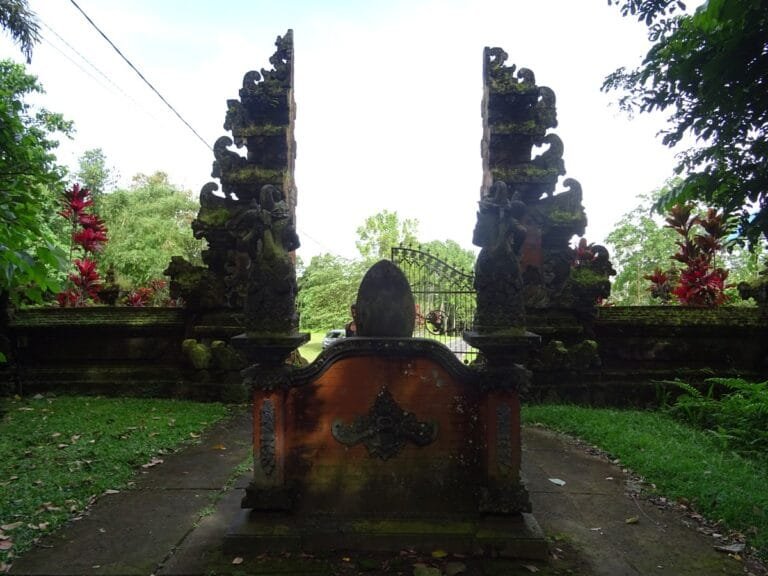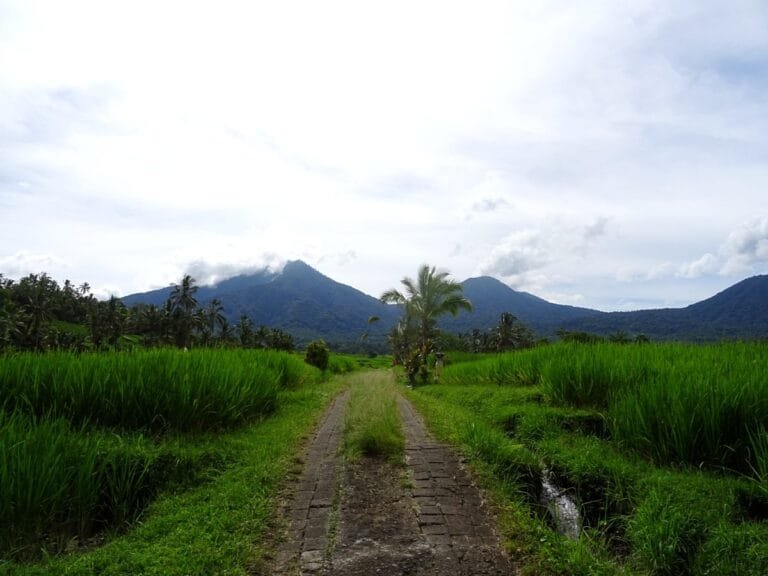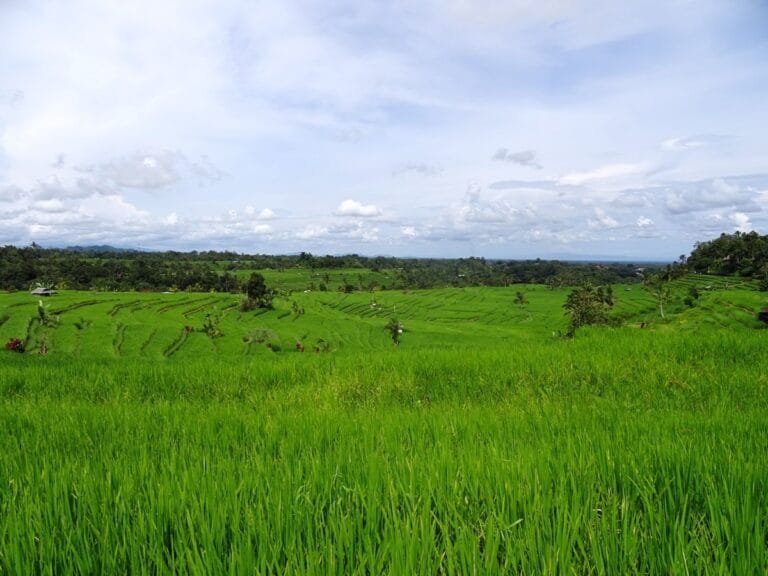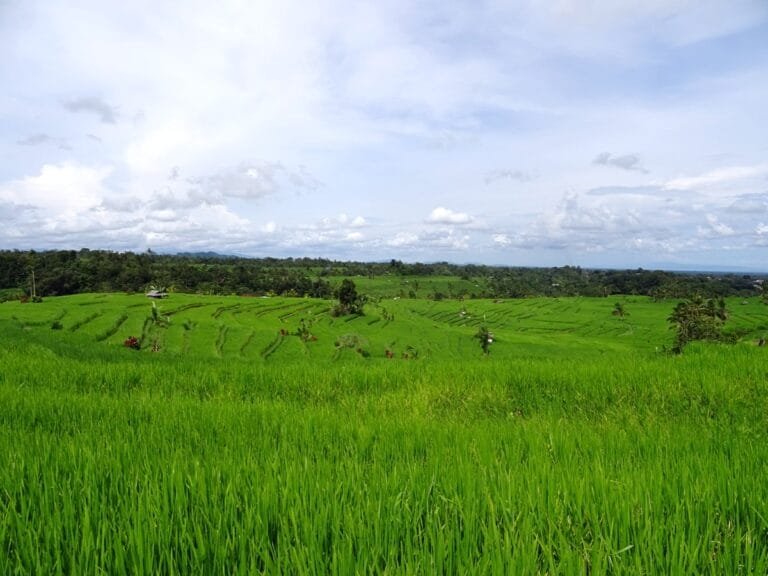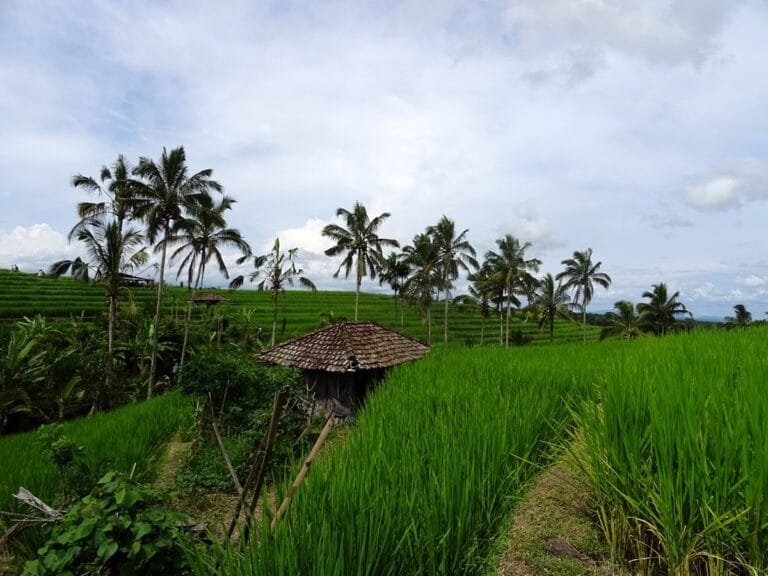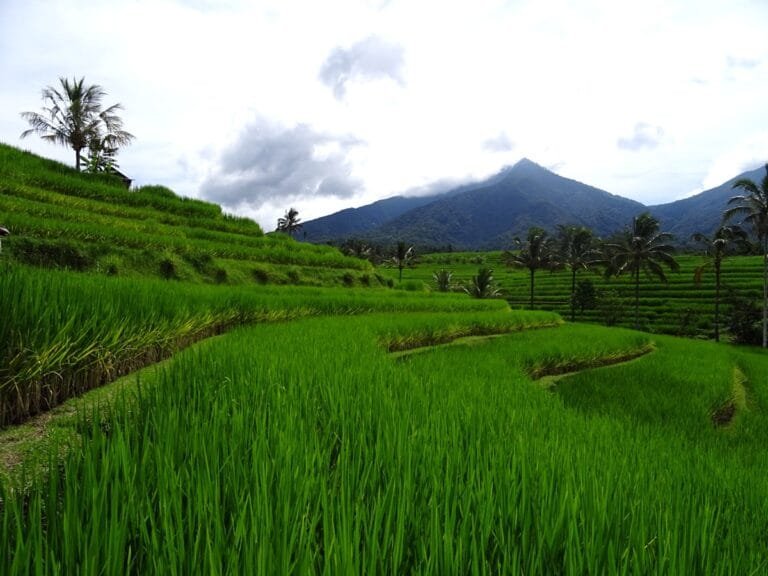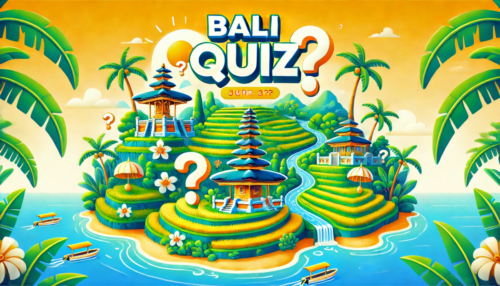Where rolling hills meet intricate landscapes, Jatiluwih Rice Terrace is a testament to Bali’s agrarian beauty and spirituality.
Bali’s UNESCO World Heritage Landscape
Nestled in the cool, mountainous region of Tabanan in central Bali, Jatiluwih Rice Terrace offers one of the island’s most stunning and expansive views of rice paddies. Recognized as a UNESCO World Heritage Site, Jatiluwih is renowned for its vast, panoramic landscapes and its use of the traditional subak irrigation system, a centuries-old method that showcases Bali’s harmonious relationship between people, land, and water. Spanning over 600 hectares of rice fields, the terraces are set against a backdrop of the island’s lush hills and mountains, creating a mesmerizing and tranquil scene.
Jatiluwih is often regarded as one of the most beautiful rice terraces in Bali and is much less crowded than its more famous counterparts, such as Tegalalang. For travelers seeking a peaceful retreat into Bali’s rural heart, Jatiluwih offers a unique combination of natural beauty, cultural significance, and a chance to witness traditional Balinese farming practices firsthand.
What to Expect at Jatiluwih Rice Terrace
The landscape at Jatiluwih Rice Terrace unfolds in a series of terraced steps that stretch as far as the eye can see, following the natural contours of the land. The terraces are irrigated by the ancient subak system, a cooperative method of water management that has been passed down through generations. This system not only ensures that the rice paddies receive adequate water but also reflects the Tri Hita Karana philosophy, which emphasizes the interconnectedness between humans, nature, and the divine.
As you walk along the paths that wind through the terraces, you’ll be greeted by a serene atmosphere, with the sound of birds and the occasional sight of local farmers tending to their crops. Jatiluwih’s rice fields are particularly beautiful during the growing season, when the paddies are full of water, creating mirror-like reflections of the sky. The terraces are equally captivating during harvest time, when the rice plants turn golden, and the farmers begin gathering their crops.
The terraces are surrounded by forested hills, creating a lush and green backdrop that makes Jatiluwih feel like a world away from Bali’s bustling tourist areas. Several walking and cycling trails run through the rice fields, allowing visitors to explore the area at their own pace. Along the way, you may encounter small temples, which the local farmers use to make offerings to the rice goddess Dewi Sri, seeking her blessings for a bountiful harvest.
TIP: To fully experience the beauty of Jatiluwih, plan to visit early in the morning or late in the afternoon, when the light is soft, and the terraces are bathed in golden sunlight. The early morning mist often adds a magical touch to the landscape.
Trekking and Exploring Jatiluwih Rice Terrace
One of the best ways to explore Jatiluwih is by taking a self-guided trek through the rice fields. There are several marked trails, ranging from short walks of around 1.5 kilometers to longer treks that can take up to 5 kilometers or more. The paths are well-maintained and offer a variety of viewpoints, where you can stop to admire the expansive terraces and take photos.
The trekking routes wind through the terraces and give you a close-up look at the intricate irrigation channels that keep the fields lush and productive. Along the way, you’ll have the chance to observe farmers going about their daily routines, planting, maintaining, and harvesting rice by hand. Many farmers are happy to greet visitors, and you may even be invited to join in their work if you’re interested in learning more about traditional Balinese agriculture.
For those looking for a more guided experience, local guides are available to offer insights into the history of the terraces, the significance of the subak system, and the role of rice in Balinese culture. These guided tours often include visits to small temples and viewpoints that may not be easily accessible on your own.
TIP: Wear comfortable walking shoes, as the paths can be uneven in some areas. Bring sunscreen, a hat, and plenty of water, as there is little shade along the trails.
The Cultural Significance of Jatiluwih and the Subak System
Jatiluwih Rice Terrace is part of Bali’s broader Cultural Landscape of Bali Province, which was recognized as a UNESCO World Heritage Site in 2012. This designation highlights the importance of the subak system, which has been used in Bali for more than 1,000 years. The subak system is not just an irrigation method; it is a reflection of Bali’s deeply spiritual relationship with the land, where the cultivation of rice is considered a sacred task.
The subak system is managed by local water cooperatives, which ensure that the water from nearby rivers and springs is distributed fairly among all farmers. This cooperative management is based on Tri Hita Karana, a Balinese philosophy that emphasizes the balance between humans, nature, and the gods. The system is also a social structure that brings together the community, as farmers work together to maintain the irrigation channels, resolve disputes, and perform rituals.
Throughout the terraces, you’ll see small shrines and temples dedicated to Dewi Sri, the rice goddess, where farmers make offerings to ensure the success of their crops. This spiritual connection between the people, the land, and the gods is what makes Jatiluwih such a special place, as it embodies the harmonious balance that is central to Balinese life.
TIP: If you’re interested in learning more about the subak system and its cultural significance, consider visiting the Subak Museum in Tabanan, which offers a detailed look at how the system works and its importance to Bali’s history.
Jatiluwih in Comparison to Other Rice Terraces
While Bali is home to several beautiful rice terraces, Jatiluwih stands out for its size, serenity, and UNESCO status. Unlike the more tourist-heavy Tegalalang Rice Terrace, which can get crowded during peak hours, Jatiluwih offers a more peaceful and immersive experience. The terraces here cover a much larger area, and the absence of large crowds allows you to fully appreciate the natural beauty and cultural significance of the landscape.
Jatiluwih is also known for its cooler climate, thanks to its elevation of around 700 meters above sea level. The cooler temperatures make it a pleasant place to visit year-round, and the higher altitude provides sweeping views of the surrounding hills and valleys.
A Journey into Bali’s Agrarian Heart
Jatiluwih Rice Terrace offers an unparalleled glimpse into Bali’s agrarian culture, where the beauty of the landscape is matched only by its cultural and spiritual significance. For travelers seeking to experience the authentic side of Bali, Jatiluwih is the perfect destination to connect with the island’s rich traditions and stunning natural beauty.
Whether you’re hiking through the terraces, learning about the ancient subak system, or simply enjoying the tranquility of the area, Jatiluwih promises an unforgettable experience. With its sweeping views, cooler climate, and deeply rooted cultural heritage, Jatiluwih Rice Terrace is a must-visit for anyone looking to explore Bali’s timeless connection to the land.






